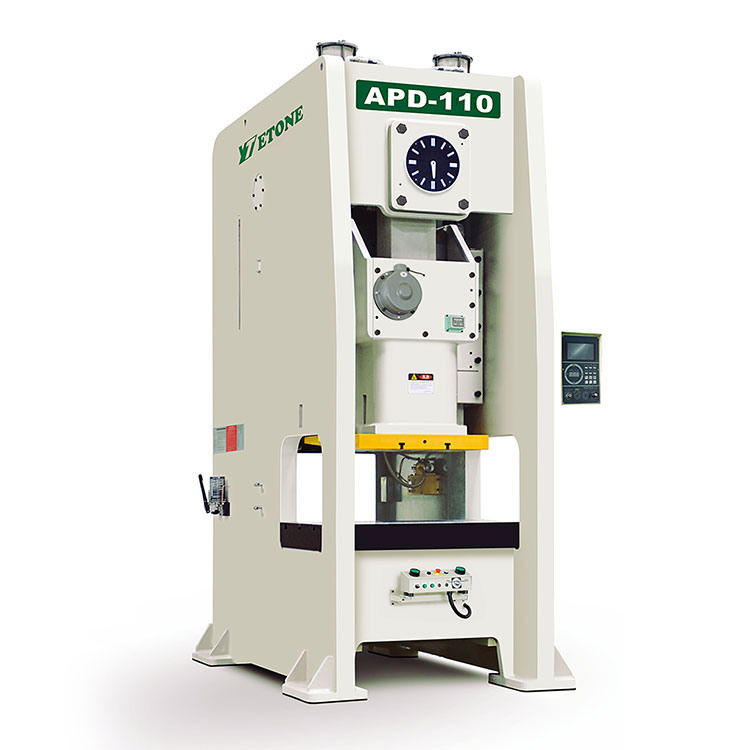D-type power presses usually refer to presses driven by electric motors or other power sources, and are widely used in multiple industrial fields such as stamping, die casting, molding, and compression. Its classification standards are usually based on different parameters, such as drive mode, working principle, pressure size, control method, etc. The following are common classification standards:
1. Classification by drive mode:
Electric drive type: powered by electric motors, common in most industrial applications. Depending on the motor, it may include AC motors, DC motors, etc.
Hydraulic drive type: powered by hydraulic systems, suitable for occasions requiring greater pressure or precision control, and often used for heavy or high-load processing.
Pneumatic drive type: driven by pneumatic systems, suitable for light loads, high-speed stamping, etc., and often used in fast production environments.
2. Classification by pressure size:
Small power press: The pressure is within tens of tons, usually used for small batch production or precision processing, such as stamping and molding of small parts.
Medium power press: The pressure is between tens of tons and hundreds of tons, suitable for medium-scale production operations.
Large power press: The pressure is generally above several hundred tons, which is suitable for mass production or heavier processing tasks, such as stamping of large metal sheets.
3. Classification by working mode:
Single-acting power press: The working mode of the press is single pressure or stamping, and one operation is completed in each cycle, which is suitable for simple pressing or stamping tasks.
Double-acting power press: In addition to single pressing, it can also perform stretching or other complex processing actions, which is suitable for diversified process requirements.
4. Classification by structural form:
Open power press: The working area is open, which is convenient for adjusting molds and loading and unloading workpieces, and is suitable for production environments where molds are frequently replaced.
Closed power press: The working area is closed, providing greater pressure and stability, and is suitable for high-precision and high-load work.
Frame power press: The structure is frame-shaped, with high stability and strength, suitable for heavy-load and high-precision stamping or forming operations.
5. Classification by control method:
Manual control type: The start and stop of the press is controlled by manual buttons or switch operations, which is suitable for simple, low-frequency operations.
Automatic control type: adopts PLC or other automatic control systems, suitable for mass production, and can improve production efficiency.
Semi-automatic control type: partial process automation, usually requires manual assistance, suitable for environments with high production efficiency.
6. Classification by use:
Stamping power press: used for stamping, cutting, stretching and other processing of metal sheets, widely used in automobiles, home appliances and other fields.
Die-casting power press: mainly used for metal casting, suitable for casting of metals such as aluminum and zinc alloys.
Forming power press: used for molding processing of materials such as plastics and rubber, suitable for injection molding, rubber pressing and other processes.
Assembly power press: used for workpiece assembly, pressing and other operations, commonly used in assembly line production.
7. Classification by performance:
High-precision type: suitable for occasions requiring precise pressure control and high processing accuracy, such as precision electronics, optical parts processing, etc.
High-load type: used in high-pressure and heavy-load working environments, suitable for large-scale metal processing, pressing and other tasks.
High-efficiency type: in response to the demand for high production efficiency, it usually has a higher operating speed and stability, suitable for mass production.
8. Classification by technical requirements:
General type: suitable for general production tasks, easy to operate, relatively low cost, widely used in various conventional processing.
Energy-saving type: with high energy efficiency and energy-saving design, suitable for industrial production with high requirements for energy consumption.
Multi-function type: capable of performing multiple processing tasks at the same time, suitable for flexible and changeable production needs.
9. Classification by market field:
General power press: suitable for most industrial fields and can meet common production needs.
Special power press: customized according to the requirements of specific industries, usually different in design and function to meet certain specific processing needs.
Conclusion, the classification standards of D-type power press mainly involve driving mode, pressure size, structural form, working mode and other aspects. Choosing a suitable power press is of great significance to meet different production needs, improve work efficiency and ensure product quality.


